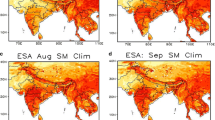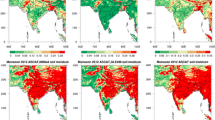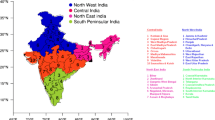Abstract
Recently available European Space Agency Climate Change Initiative (ESACCI) soil moisture dataset, derived by merging soil moisture values calculated using measurements from satellite-based active and passive sensors, is validated over the Indian region using in-situ observations from 117 Continental Tropical Convergence Zone (CTCZ) Programme stations spread across India. The dataset is compared for the monsoon season (June–September: JJAS) of two years – 2011–2012, over six regional domains which differ in soil characteristics and mean soil moisture values, thus taking the spatial heterogeneity into account. Evaluation shows that the mean JJAS ESACCI volumetric soil moisture is 25.5% (\(\hbox {m}^{3}\,\hbox {m}^{-3}\)), with an intra-seasonal standard deviation of 6%. The root mean squared difference (RMSD) between ESACCI soil moisture product and CTCZ observations is 10% over the Indian region. Over smaller homogeneous regions, the RMSD values between the two products are smaller than 5%, except over southern India and north-east India. Overall, the ESACCI soil moisture dataset is in good agreement with the CTCZ in-situ soil moisture observations, and has relatively higher accuracy over the plains of northern and central India, as compared to other regions. However, the ESACCI soil moisture dataset shows higher intra-seasonal variability at shorter time-scale of 2–4 days, as compared to the CTCZ observations, possibly due to the difference in the soil sampling depths between the two datasets.








Similar content being viewed by others
References
Agrawal S and Chakraborty A 2016 Role of surface hydrology in determining the seasonal cycle of Indian summer monsoon in a general circulation model; Hydrol. Earth. Syst. Discuss. 1–33.
Albergel C, de Rosnay P, Gruhier C, Muñoz-Sabater J, Hasenauer S, Isaksen L, Kerr Y and Wagner W 2012 Evaluation of remotely sensed and modelled soil moisture products using global ground-based in-situ observations; Remote Sens. Environ. 118 215–226.
An R, Zhang L, Wang Z, Quaye-Ballard J A, You J, Shen X, Gao W, Huang L, Zhao Y and Ke Z 2016 Validation of the ESACCI soil moisture product in China; Int. J. Appl. Earth Obs. 48 28–36, Advances in the validation and application of remotely sensed soil moisture – Part 2.
Bitar A A, Leroux D, Kerr Y H, Merlin O, Richaume P, Sahoo A and Wood E F 2012 Evaluation of SMOS soil moisture products over continental US using the scan/snotel network; IEEE Trans. Geosci. Remote 50(5) 1572–1586.
Chakraborty A and Agrawal S 2017 Role of west asian surface pressure in summer monsoon onset over Central India; Environ. Res. Lett. 12(7) 074002.
Dorigo W, Gruber A, Jeu R D, Wagner W, Stacke T, Loew A, Albergel C, Brocca L, Chung D, Parinussa R and Kidd R 2015 Evaluation of the ESACCI soil moisture product using ground-based observations; Remote Sens. Environ. 162 380–395.
Douville H and Chauvin F 2000 Relevance of soil moisture for seasonal climate predictions: A preliminary study; Clim. Dyn. 16(10) 719–736.
Draper C S, Walker J P, Steinle P J, de Jeu R A and Holmes T R 2009 An evaluation of AMSR–E derived soil moisture over Australia; Remote Sens. Environ. 113(4) 703–710.
Ikonen J, Smolander T, Rautiainen K, Cohen J, Lemmetyinen J, Salminen M and Pulliainen J 2018 Spatially distributed evaluation of ESACCI soil moisture products in a northern boreal forest environment; Geosciences 8(2).
Koster R D, Dirmeyer P A, Guo Z, Bonan G, Chan E, Cox P, Gordon C T, Kanae S, Kowalczyk E, Lawrence D, Liu P, Lu C-H, Malyshev S, McAvaney B, Mitchell K, Mocko D, Oki T, Oleson K, Pitman A, Sud Y C, Taylor C M, Verseghy D, Vasic R, Xue Y and Yamada T 2004 Regions of strong coupling between soil moisture and precipitation; Science 305(5687) 1138–1140.
Liu Y, Dorigo W, Parinussa R, de Jeu R, Wagner W, McCabe M, Evans J and van Dijk A 2012 Trend-preserving blending of passive and active microwave soil moisture retrievals; Remote Sens. Environ. 123 280–297.
Liu Y Y, Parinussa R M, Dorigo W A, De Jeu R A M, Wagner W, van Dijk A I J M, McCabe, M F and Evans J P 2011 Developing an improved soil moisture dataset by blending passive and active microwave satellite-based retrievals; Hydrol. Earth Syst. Sci. 15(2) 425–436.
May W, Meier A, Rummukainen M, Berg A, Chéruy F and Hagemann S 2015 Contributions of soil moisture interactions to climate change in the tropics in the GLACE–CMIP5 experiment; Clim. Dyn. 45(11) 3275–3297.
May W, Rummukainen M, Chéruy F, Hagemann S and Meier A 2017 Contributions of soil moisture interactions to future precipitation changes in the GLACE-CMIP5 experiment; Clim. dyn. 49(5) 1681–1704.
McNally A, Shukla S, Arsenault K R, Wang S, Peters-Lidard C D and Verdin J P 2016 Evaluating ESACCI soil moisture in east Africa; Int. Appl. Earth Obs. 48 96–109, Advances in the validation and application of remotely sensed soil moisture – Part 2.
Ni-Meister W, Houser P R and Walker J P 2006 Soil moisture initialization for climate prediction: Assimilation of scanning multifrequency microwave radiometer soil moisture data into a land surface model; J. Geophys. Res.-Atmos. 111(D20).
Rajeevan M, Bhate J, Kale J D and Lal B 2006 High resolution daily gridded rainfall data for the Indian region: Analysis of break and active monsoon spells; Curr. Sci. 91(3) 296–306.
Rodell M, Houser P R, Berg A A and Famiglietti J S 2005 Evaluation of 10 methods for initializing a land surface model; J. Hydrometeorol. 6(2) 146–155.
Wagner W, Dorigo W, de Jeu R, Fernandez D, Benveniste J, Haas E and Ertl M 2012 Fusion of active and passive microwave observations to create an essential climate variable data record on soil moisture; ISPRS Ann. Photogram. Remote Sens. Spat. Infor. Sci. I–7 315–321.
Acknowledgements
SA acknowledges the Grantham Fellowship received from Divecha Centre for Climate Change, IISc. AC acknowledges MoES for providing funding under the CTCZ and Monsoon Misson programs. Authors wish to thank Prof. J Srinivasan for his valuable suggestions. Authors are grateful to Prof. G S Bhat and Dr R Mali for providing useful information regarding CTCZ soil moisture data and sensors. Authors acknowledge the use of data from European Space Agency and the India Meteorological Department.
Author information
Authors and Affiliations
Corresponding author
Additional information
Communicated by N V Chalapathi Rao
Rights and permissions
About this article
Cite this article
Agrawal, S., Chakraborty, A. Evaluation of ESACCI satellite soil moisture product using in-situ CTCZ observations over India. J Earth Syst Sci 129, 129 (2020). https://doi.org/10.1007/s12040-020-01384-2
Received:
Revised:
Accepted:
Published:
DOI: https://doi.org/10.1007/s12040-020-01384-2




